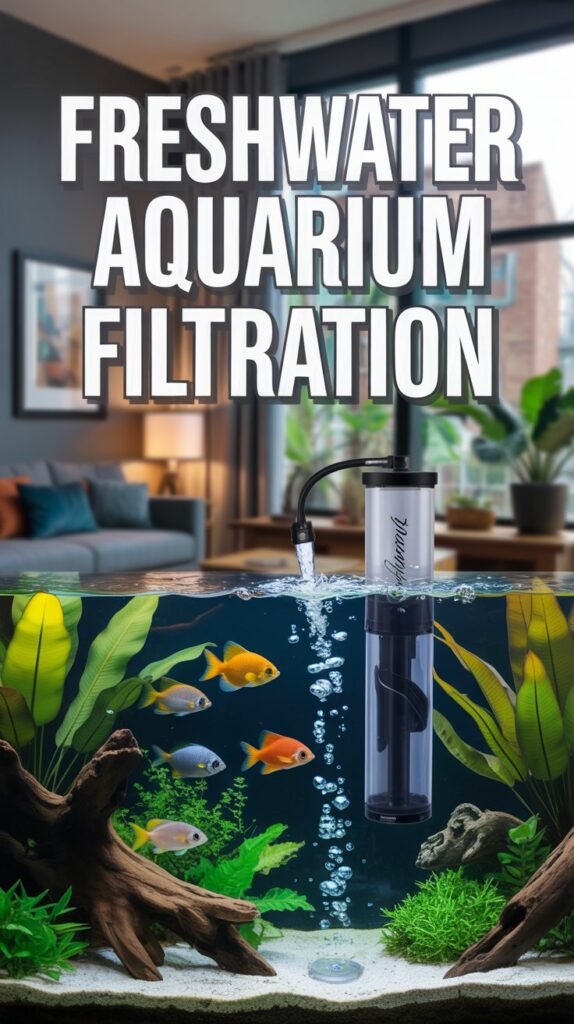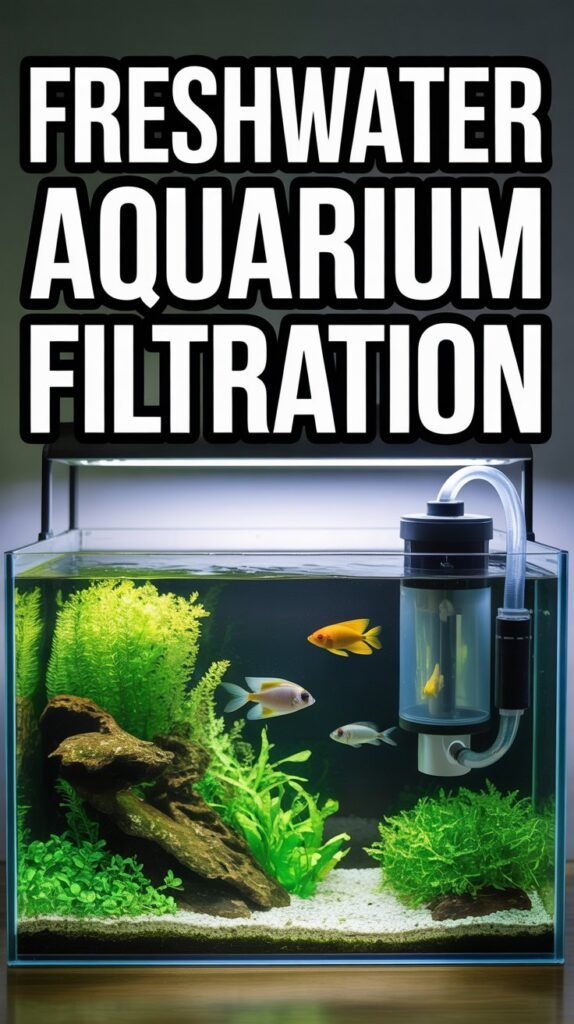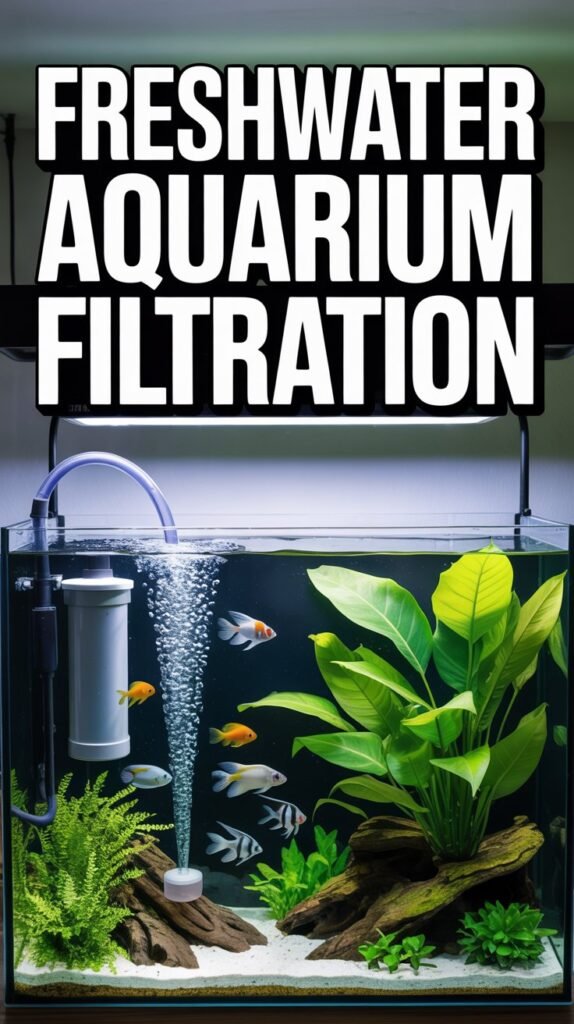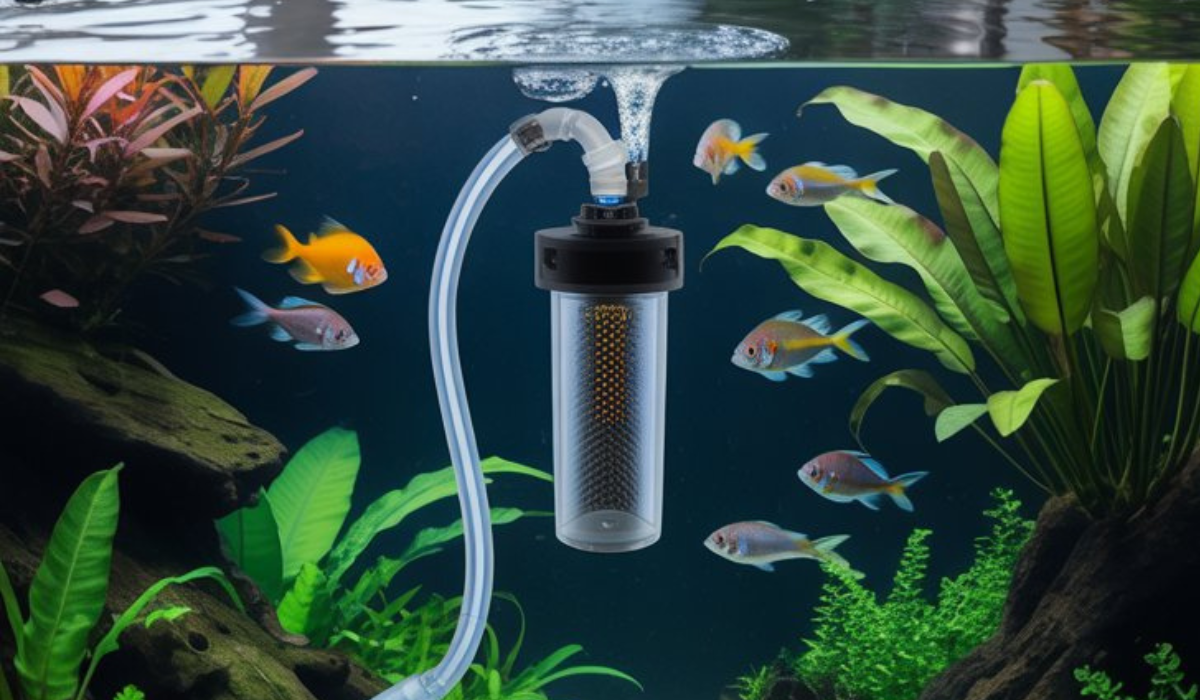Keeping a freshwater aquarium healthy and crystal clear depends heavily on one crucial element — filtration. A good filtration system doesn’t just remove visible debris; it also supports beneficial bacteria, stabilizes water chemistry, and creates a safe environment for fish and plants.
Whether you’re new to fishkeeping or an experienced aquarist, understanding freshwater aquarium filtration is essential. In this comprehensive guide, we’ll cover how filtration works, the types of filters, how to choose the right one, and tips for long-term maintenance.
What Is Freshwater Aquarium Filtration?
Filtration in a freshwater aquarium refers to the process of cleaning and purifying the water by removing waste, toxins, and debris. It mimics the natural purification that happens in rivers and lakes, where flowing water and microorganisms constantly cleanse the environment.
A proper filtration system ensures your fish have access to clean, oxygen-rich water, which helps them stay active, vibrant, and healthy. Without adequate filtration, harmful waste can accumulate and lead to dangerous ammonia and nitrite spikes.
Why Is Filtration Important in Freshwater Aquariums?

A freshwater aquarium is a closed ecosystem. Everything that goes in — food, waste, and decaying plant matter — stays inside unless it’s removed. Without a filter, these substances break down and release toxins harmful to fish and plants.
Here’s why filtration is vital:
- Removes Waste: Fish waste, uneaten food, and decaying plants create ammonia, which is toxic. Filters remove and process this waste.
- Supports Beneficial Bacteria: Filters provide a surface for beneficial bacteria that convert harmful compounds into safer forms.
- Improves Water Clarity: Mechanical filtration traps particles that make water cloudy.
- Enhances Oxygen Exchange: Filters promote water movement, helping oxygen circulate.
- Stabilizes the Ecosystem: Consistent filtration maintains water quality, reducing fish stress and disease.
Without filtration, you would need to perform frequent and large water changes to keep the water safe — something most aquarists find impractical.
The Three Stages of Aquarium Filtration
A complete filtration system typically performs three types of filtration: mechanical, biological, and chemical. Each type plays a unique role in maintaining balance in your aquarium.
1. Mechanical Filtration
Purpose: To remove solid particles and debris from the water.
How it works:
Mechanical filters use sponges, pads, or filter floss to trap uneaten food, fish waste, and plant debris as water passes through.
Examples of mechanical media:
- Filter floss or pads
- Sponge filters
- Foam inserts
Maintenance tip:
Rinse mechanical media in dechlorinated water or old tank water every 1–2 weeks. Avoid using tap water, as chlorine can kill beneficial bacteria.
2. Biological Filtration
Purpose: To convert toxic waste into less harmful substances.
How it works:
Beneficial bacteria colonize the filter media and break down ammonia (NH₃) into nitrite (NO₂⁻) and then nitrate (NO₃⁻). This is known as the nitrogen cycle, which is crucial for fish health.
Examples of biological media:
- Ceramic rings
- Bio balls
- Lava rock
- Sponge filters
Maintenance tip:
Never replace all biological media at once — it will destroy the bacterial colony and crash the cycle.
3. Chemical Filtration
Purpose: To remove dissolved substances and toxins from the water.
How it works:
Chemical media use adsorptive materials (like activated carbon or resins) to absorb impurities such as medications, chlorine, tannins, and odors.
Examples of chemical media:
- Activated carbon
- Zeolite
- Phosphate remover
- Ion-exchange resins
Maintenance tip:
Replace chemical media every 3–4 weeks, as they lose effectiveness over time.
Types of Freshwater Aquarium Filters

Different filters serve different purposes. Choosing the right type depends on your aquarium’s size, stocking level, and maintenance routine. Below are the most common types of freshwater aquarium filters.
1. Sponge Filter
Best for: Nano tanks, shrimp tanks, fry tanks, and breeding setups.
Sponge filters are powered by an air pump that draws water through a sponge, trapping debris and providing an excellent surface for beneficial bacteria.
Pros:
- Affordable and easy to use
- Gentle water flow — ideal for fry and shrimp
- Excellent biological filtration
Cons:
- Limited mechanical filtration
- Requires air pump noise tolerance
2. Hang-On-Back (HOB) Filter
Best for: Small to medium-sized tanks (10–55 gallons).
HOB filters hang on the back of the aquarium, drawing water through an intake tube and passing it through multiple filtration stages.
Pros:
- Easy to install and maintain
- Provides mechanical, biological, and chemical filtration
- Adjustable flow rate
Cons:
- Visible on the tank’s exterior
- Limited media capacity for large tanks
3. Canister Filter
Best for: Medium to large aquariums (30–150+ gallons).
Canister filters sit below the aquarium and use hoses to pull water out, filter it through various media, and return it clean.
Pros:
- Superior filtration capacity
- Customizable media
- Quiet operation
Cons:
- More expensive
- Requires periodic deep cleaning
4. Internal Filter
Best for: Small aquariums and hospital tanks.
Internal filters are submersible units placed directly inside the tank. They are compact and often include sponges and carbon cartridges.
Pros:
- Space-efficient
- Simple installation
- Good for small setups
Cons:
- Takes up space inside the tank
- Limited media volume
5. Undergravel Filter
Best for: Traditional low-tech aquariums and small community tanks.
Undergravel filters use a plate beneath the substrate connected to an air pump or powerhead. Water is drawn through the gravel, allowing bacteria to thrive.
Pros:
- Promotes excellent biological filtration
- Low-cost option
Cons:
- Difficult to clean
- Can clog with debris over time
6. Power Filter
Best for: Standard freshwater setups.
Similar to HOB filters, power filters use electric motors to pull water through different media types for effective filtration.
Pros:
- Reliable and efficient
- Easy to replace cartridges
Cons:
- Cartridges can be expensive
- Some models produce noticeable water flow noise
7. Sump Filter
Best for: Advanced and large freshwater systems.
A sump is a secondary tank (usually placed below the main aquarium) that houses filtration equipment and additional water volume.
Pros:
- Increases water volume and stability
- Easy equipment concealment
- Customizable filter media layout
Cons:
- Expensive and complex setup
- Requires plumbing knowledge
Choosing the Right Filter for Your Freshwater Aquarium

To choose the best filter, consider the following factors:
1. Tank Size
The larger the aquarium, the more powerful the filter needs to be. Check the GPH (gallons per hour) rating — ideally, your filter should turn over the tank’s volume 4–6 times per hour.
Example:
- 20-gallon tank → 80–120 GPH
- 50-gallon tank → 200–300 GPH
2. Stocking Level
Heavily stocked tanks produce more waste and need stronger filtration.
3. Type of Fish
Delicate species like bettas prefer gentle flow, while goldfish or cichlids need robust filtration.
4. Maintenance Routine
Choose a filter you can easily clean and service regularly.
5. Budget
While budget filters are available, investing in a reliable system pays off in the long run.
How to Maintain Your Aquarium Filter
A well-maintained filter ensures consistent performance and healthy water quality. Here are essential maintenance practices:
1. Regular Cleaning
- Rinse filter media in aquarium water (not tap water) every 2–4 weeks.
- Clean impellers, tubing, and intakes to prevent clogs.
2. Replace Media Carefully
- Never replace all media at once — alternate between different stages.
- Keep some old media in the filter to preserve beneficial bacteria.
3. Check Flow Rate
- A decrease in flow means the filter is clogged. Clean or replace the sponge or pads.
4. Monitor Water Parameters
Regularly test for ammonia, nitrite, nitrate, and pH. If ammonia or nitrite levels rise, your biological filtration may be compromised.
Signs of Poor Filtration
If your aquarium’s filtration system isn’t working properly, you may notice:
- Cloudy or murky water
- Algae growth
- Fish gasping at the surface
- Foul odor
- Slime buildup on decorations
- Elevated ammonia or nitrite levels
These are clear signs that your filter needs cleaning, upgrading, or replacement.
Supplemental Filtration and Natural Methods
While mechanical filters are essential, some aquarists enhance filtration with natural or supplemental methods:
1. Live Plants
Plants absorb ammonia, nitrites, and nitrates — acting as natural biological filters.
Examples: Java fern, Anubias, Hornwort, and Amazon sword.
2. Beneficial Bacteria Boosters
Bacterial supplements like Seachem Stability help establish and maintain healthy colonies.
3. Activated Carbon or Purigen
These products help remove dissolved organic compounds and keep water crystal clear.
4. Regular Water Changes
Even with good filtration, partial water changes (20–30% weekly) prevent toxin buildup.
Common Filtration Mistakes to Avoid
- Over-cleaning the filter media – Kills beneficial bacteria.
- Using tap water for rinsing – Chlorine destroys bacterial colonies.
- Overstocking fish – Overloads filtration capacity.
- Skipping maintenance – Leads to clogs and ammonia spikes.
- Relying solely on chemical filtration – Use it as a supplement, not a substitute.
Avoiding these mistakes will keep your aquarium stable and healthy for years.
DIY Freshwater Aquarium Filtration Ideas
If you enjoy DIY projects, here are creative and effective homemade filtration methods:
- Bottle Sponge Filter: Made from a plastic bottle, air stone, and sponge.
- DIY Canister Filter: Using PVC pipes and a water pump.
- Refugium Setup: A small chamber filled with plants and bio-media for natural filtration.
DIY filters can be cost-effective and rewarding when properly maintained.
Benefits of Proper Freshwater Aquarium Filtration
- Healthier fish and plants
- Crystal clear water
- Stable nitrogen cycle
- Reduced maintenance frequency
- Longer lifespan of aquarium inhabitants
Ultimately, good filtration ensures a balanced, thriving ecosystem where life flourishes naturally.
Conclusion
A well-functioning freshwater aquarium filtration system is the foundation of a successful aquarium. It removes waste, supports biological balance, and maintains water clarity — all essential for healthy fish and plants.
By understanding how each filtration type works and maintaining your system properly, you can create a clean, stable, and beautiful aquarium that thrives for years. Remember, the best filter isn’t just the most powerful — it’s the one that meets the needs of your aquarium’s unique ecosystem.
FAQs about Freshwater Aquarium Filtration
1. How often should I clean my aquarium filter?
Every 2–4 weeks is ideal. Clean only part of the filter media at a time to preserve beneficial bacteria.
2. Can I use multiple filters in one tank?
Yes. Using two filters increases efficiency and provides backup in case one fails.
3. Do planted tanks need filters?
Yes. Even though plants help with biological filtration, filters keep the water clear and oxygenated.
4. Is a filter necessary for small aquariums?
Even nano tanks benefit from sponge or small internal filters to maintain water quality.
5. How long should I run my aquarium filter each day?
24/7. Filters must run continuously to maintain the nitrogen cycle.
6. Can filters remove algae?
Indirectly. Filters remove waste that feeds algae, but manual cleaning and balanced lighting are still needed.
7. Do I need to replace filter media regularly?
Mechanical and chemical media should be replaced periodically. Biological media should only be rinsed gently and reused.
8. Why is my filter noisy?
It could be due to trapped air, debris in the impeller, or low water levels. Cleaning and adjusting usually solve the issue.

